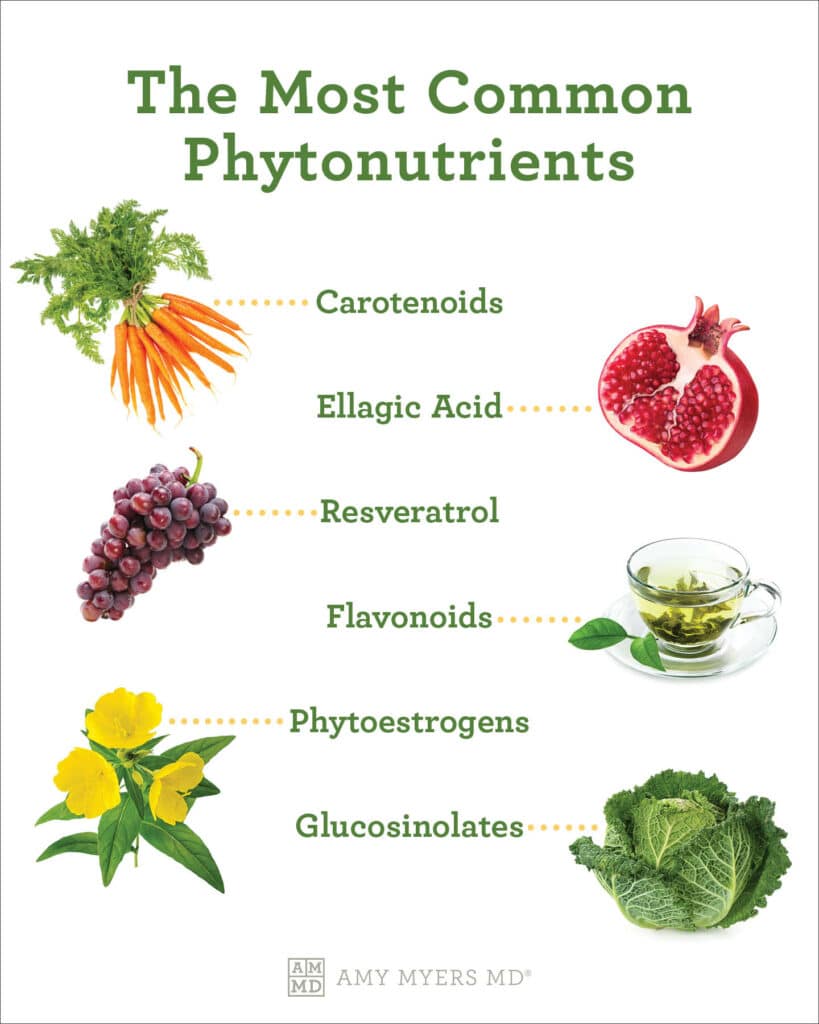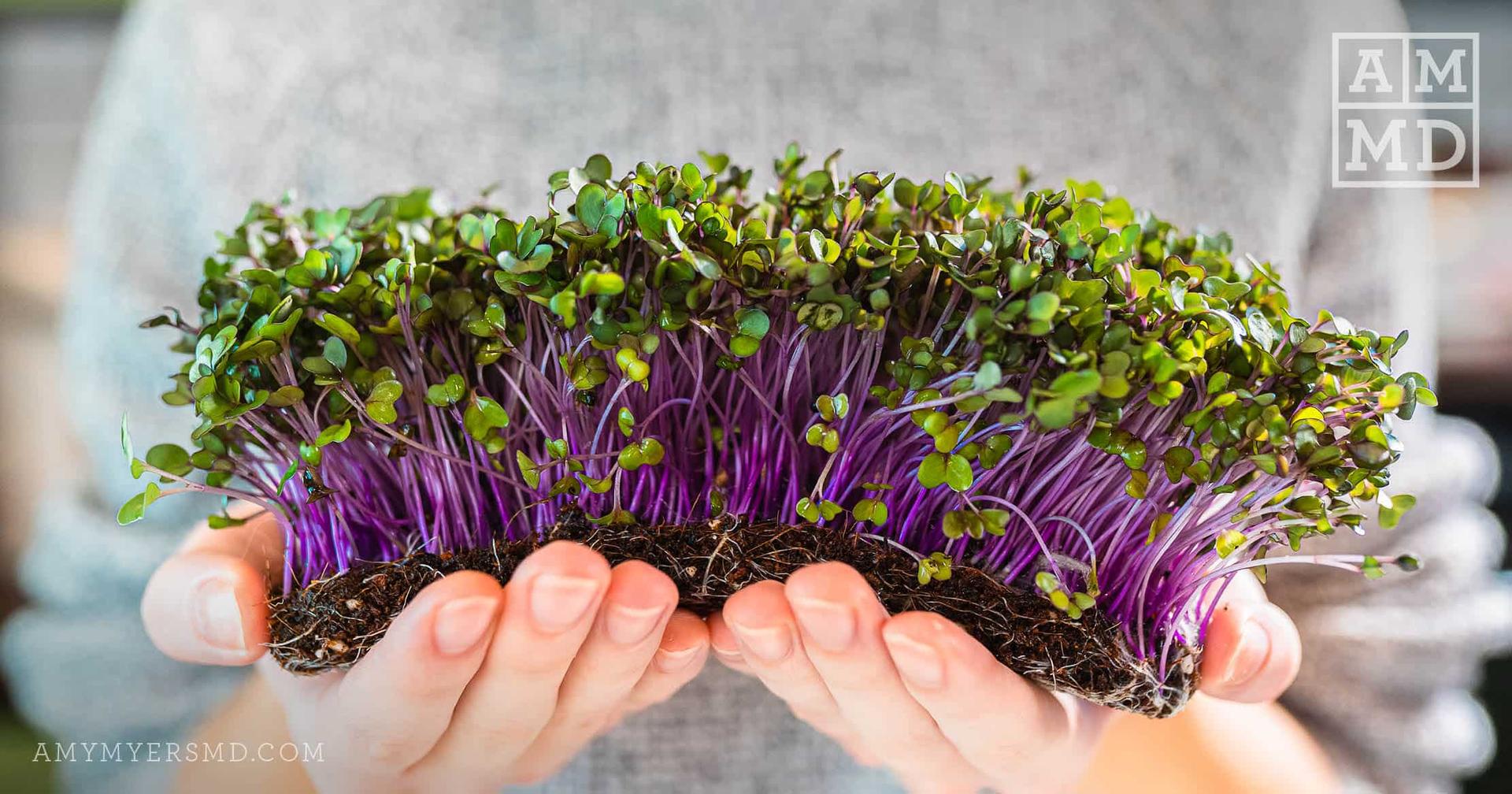Food is your body’s primary energy source, yet it is so much more than that. Food provides your body with the chemicals it needs to perform various functions. It does this through three different types of nutrients – micronutrients (vitamins and minerals), macronutrients (carbohydrates and protein), and phytonutrients. So, what are phytonutrients?
Phytonutrients, also known as phytochemicals, are compounds naturally found in plants that protect them from germs, fungi, and disease. These properties make them excellent sources of antioxidants that can clean up damage caused by free radicals. I’ll talk more about free radicals in just a minute.
Fruits and vegetables get their rich, vibrant colors from phytonutrients, which are also found in many herbs, spices, seeds, and nuts. I will tell you more about foods containing phytonutrients, the different phytonutrients, and how you can conveniently incorporate more phytonutrients into your diet. First, I will answer the question: What are phytonutrients?
Phytonutrients: The Plant Superfood
Many plants often grow in hostile and volatile conditions that are affected by pests and climate. It also doesn’t help that our modern cultivation practices focus on speeding growth, increasing size, and improving pest resistance. The increased production of artificial fertilizers decreases concentrations of minerals in plants and their natural defenses.
These natural defenses, known as phytochemicals, are how plants keep themselves safe and healthy. Think of these chemicals as you would your body’s immune system. When a plant detects a foreign invader such as a pest, phytochemicals recognize it and begin attacking it the same way your immune system does to viruses and bacteria.1
There are over 1,000 different phytonutrients, and although they naturally occur in virtually every plant, different types occur in specific families of plants. I’ll talk more about this in just a bit.
Phytonutrients are powerful defenders of health because of their antioxidant properties that help facilitate a healthy inflammatory response. Consuming phytonutrients stimulate enzymes that help enhance your immune system, facilitate detoxification, repair your DNA after toxin exposure, improve cardiovascular health, promote optimal estrogen metabolism, and detoxify certain carcinogens.
Phytonutrients are different from micronutrients and macronutrients. Your body does not need phytonutrients to sustain life. However, they are just as essential to your health because they can reduce free radicals and reverse the effects of oxidative stress. After all, we don’t want to just live – we want to achieve optimal health!
Free Radicals and Oxidative Stress
Everything, including the cells in our bodies, is made up of atoms that contain a nucleus made up of protons and neutrons. That nucleus is surrounded by constantly moving electrons, typically attached to atoms in pairs.
When atoms have the required number of electrons, they are stable. When an atom has an odd number of electrons, it hunts for a spare electron throughout your body. In an attempt to replace the missing electron and become stable. The molecules missing an electron become free radicals that try to steal electrons from healthy cells and damage them.
Think of these damaged cells, or free radicals, as rusty particles traveling through your bloodstream and causing inflammation. This is known as oxidative stress.
Oxidative stress occurs when there’s an imbalance of antioxidants and free radicals. As I mentioned, free radicals are atoms looking for a spare electron to meet the requirement of having pairs of electrons. Antioxidants supply free radicals with the electron they need to prevent damage to healthy cells.
When there are more free radicals than antioxidants, the free radicals can start doing damage to cells, proteins, and your DNA. This damage over a long period of time can lead to numerous diseases such as diabetes, high blood pressure, heart disease, Alzheimer’s, and cancer.2
Your body produces antioxidants on its own to fight free radicals. However, the natural production of antioxidants can be slowed due to autoimmune disease, medications, stress, trauma, aging, infections, a poor diet, pollution, and radiation.
Your diet and lifestyle ensure you have enough antioxidants to fight free radicals. Plants containing phytonutrients are excellent sources of antioxidants. As I mentioned, there are 1,000s of different phytonutrients. Let’s talk about the most common types of phytonutrients.
The Most Common Phytonutrients
Since there are thousands of different phytonutrients, scientists classify them based on their chemical structure and break them down into classes and types. The phytonutrient classes include:
- Betalains
- Chlorophyll
- Indoles
- Organosulfides
- Phenols
- Terpenes
- Triterpenes
These classes are further broken down into ten groups, including:
- Carotenoids
- Curcuminoids
- Flavonoids
- Glucosinolates
- Hydroxycinnamic acids
- Lignans
- Lipids
- Stilbenes
- Sulfides
- Tocopherol
Of the 10 groups of phytonutrients, there are six groups that are most essential to optimal health. Let’s take a look.
 Dr. Amy Myers
September 21st, 2022
https://content.amymyersmd.com/article/what-are-phytonutrients/what are phytonutrients – infographic – Amy Myers MD®
Dr. Amy Myers
September 21st, 2022
https://content.amymyersmd.com/article/what-are-phytonutrients/what are phytonutrients – infographic – Amy Myers MD®Carotenoids
Carotenoids are the yellow, red, and orange pigments in plants such as sweet potatoes, carrots, cantaloupe, mangoes, bell peppers, and papaya. If you have a nightshade sensitivity, you want to avoid bell peppers. There are over 600 types of carotenoids, and they can only come from the foods you eat.
The most common carotenoids in food are beta-cryptoxanthin, zeaxanthin, lutein, alpha-carotene, beta-carotene, and lycopene. These carotenoids are in various fruits and vegetables. Each has distinct actions and benefits, including supporting eye health, being a free radical scavenger, facilitating an immune system response, and promoting heart health.
Since they are fat-soluble, carotenoids should be consumed along with fat for optimal absorption. Once ingested, your body converts alpha-carotene, beta-carotene, and beta-cryptoxanthin into vitamin A or natural retinol, which is beneficial for anti-aging and immune system function.
Ellagic Acid
Ellagic acid, also known as tannins, is abundant in foods such as cranberries, grapes, strawberries, raspberries, blackberries, walnuts, and pomegranates. They are well known for their antioxidant properties and for promoting a healthy inflammatory response. Additionally, ellagic acid has been used to support healthy blood glucose levels, promote brain health, and facilitate liver function. Ellagic acid is a common ingredient in many skincare products to help reduce inflammation in your skin, neutralize free radicals, and reduce hyperpigmentation.
Resveratrol
Resveratrol is a powerful antioxidant most commonly found in grapes, red wine, cocoa, blueberries, cranberries, and peanuts. It helps support healthy blood pressure, optimal brain health, and a healthy inflammatory response and regulates blood glucose levels.
The most abundant source of resveratrol is red wine, which should be avoided if you are following a low-FODMAP or Candida diet. Don’t worry! There is a way you can reap all the benefits of resveratrol without drinking red wine or eating fermented foods.
Resveratrol is a physician-formulated supplement that offers the health benefits of 25 glasses of red wine without alcohol. It is a potent free radical scavenger to assist the immune system that contains no sugar, alcohol, or sulfites and is not fermented.
Flavonoids
Flavonoids are a large, diverse group of phytonutrients found in various foods. The best sources include green tea, berries, chocolate, coffee, onions, apples, red wine, broccoli, leeks, ginger, parsley, and carrots. Green tea and coffee contain caffeine, a toxic food that should be avoided, so stick to decaffeinated versions. Flavonoids support heart health and are free radical scavengers.3
Phytoestrogens
Phytoestrogens are plant-based compounds that imitate estrogen. They are most abundant in cabbage, grains, garlic, and sprouts. When you consume phytoestrogens, your body’s estrogen receptors react the same way they respond to the estrogen. Phytoestrogens are crucial in maintaining a healthy hormone balance, and this is especially beneficial for women entering perimenopause.
Phytoestrogens also support bone health. Low bone density is common during menopause and perimenopause, so consuming phytoestrogen-rich foods is a great way to support balanced hormone levels.4
Glucosinolates
Glucosinolates are most commonly found in the Brassicaceae plant family, which includes cauliflower, broccoli, kale, cabbage, mustard, and horseradish. These vegetables are packed with essential vitamins, minerals, and fiber and are also powerful free radical scavengers that promote an inflammatory response and facilitate a healthy stress response.
Getting Optimal Amounts of Phytonutrients
Unless you spend all of your time preparing food, adding phytonutrients to your diet can be challenging. That’s why I created Organic Greens. This powder contains essential green fruits and vegetables packed with phytonutrients.
Organic Greens
Organic Greens is also rich in phytonutrients and made from 14 powerful USDA-certified organic superfoods. I added a touch of stevia and monk fruit extract for a lightly sweet flavor. It is infused with the carotenoid turmeric and the phytoestrogens from garlic to support a healthy inflammatory response.
The Final Word
Phytonutrients are essential in the fight against free radicals and are a crucial part of a healthy diet of organic whole foods. Fruits and vegetables are excellent sources of phytonutrients. Unfortunately, with our modern farming practices and our polluted environments, the phytonutrient content in our food has been diminished. The Organic Superfoods Kit is a great way to ensure you get optimal amounts of essential phytonutrients every single day.
Article Sources
- Phytonutrients – Nature’s Natural Defense. Dieticians of Canada. Unlock Food Canada. 2019.
- Everything You Should Know About Oxidative Stress. Megan Dix, RN, BSN. Healthline. 2018.
- Flavonoids: A versatile source of anticancer drugs. Maheep K. Chahar, Neelu Sharma, Mahabeer P. Dobhal, and Yogesh C. Joshi . Pharmacognosy Review. 2011.
- Preventive effects of phytoestrogens against postmenopausal osteoporosis as compared to the available therapeutic choices: An overview. Abdullah Foraih Al-Anazi, Viquar Fatima Qureshi, Khalida Javaid, and Shoeb Qureshi. Journal of Natural Science, Biology and Medicine. 2011.
